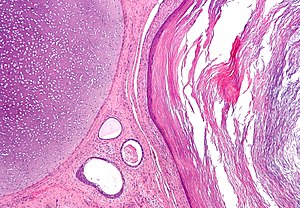Teratoma
| Teratoma | |
|---|---|
 |
|
|
Micrograph of a teratoma showing tissue from all three germ layers: mesoderm (immature cartilage - left-upper corner of image), endoderm (gastrointestinal glands - center-bottom of image) and ectoderm (epidermis - right of image). H&E stain. |
|
| Classification and external resources | |
| Specialty | Gynecology, oncology |
| ICD-10 | C62.9 (ILDS C62.930) |
| ICD-O | 9080 |
| DiseasesDB | 12966 |
| eMedicine | med/3449 |
| MeSH | D013724 |
A teratoma is a tumor with tissue or organ components resembling normal derivatives of more than one germ layer. Although the teratoma may be monodermal or polydermal (originating from one or more germ layers), its cells may differentiate in ways suggesting other germ layers. The tissues of a teratoma, although normal in themselves, may be quite different from surrounding tissues and may be highly disparate; teratomas have been reported to contain hair, teeth, bone and, very rarely, more complex organs or processes such as brain matter,eyes,torso, and hands, feet, or other limbs.
Usually, a teratoma will contain no organs but rather one or more tissues normally found in organs such as the brain, thyroid, liver, and lung. Sometimes, the teratoma has within its capsule one or more fluid-filled cysts; when a large cyst occurs, there is a potential for the teratoma to produce a structure within the cyst that resembles a fetus. Because they are encapsulated, teratomas are usually benign, although several forms of malignant teratoma are known and some of these are common forms of teratoma. A mature teratoma is typically benign and found more commonly in women, while an immature teratoma is typically malignant and is more often found in men.
Teratomas are thought to be present at birth (congenital), but small ones often remain undiscovered until much later in life.
...
Wikipedia
